The penultimate edition of The Election Wrap ranges widely. Stay tuned for next week’s post-election analysis!
ICYMI, here are part one (13 April), part two (20 April), part three (27 April), part four (4 May) and part five (11 May) of this series. Also see the latest edition of the #AusVotesHealth2022 election report card and The Accountability Report.
Lesley Russell writes:
On the whole, it has not been a very inspiring or edifying campaign, even for political tragics like me. I’m pretty dejected about the lack of vision and long-term thinking around key issues linked to health, healthcare, social supports, climate change and tackling inequalities.
Prime Minister Morrison seems to have forgotten that elections are about the future; his campaign speeches are an endless recitation of facts about his government’s record and he seems satisfied with the status quo.
In contrast, Labor’s campaign slogan is “A Better Future” and Labor Leader Anthony Albanese’s messages around this, despite the lack of detail, have resonated for many. It was also encouraging to see Albanese indicate (in an interview with his biographer Karen Middleton) that he is “determined to establish structures and a program of government that ensures that Labor does govern long-term.” I’m hoping this means that Labor policies – should it win government – will have some vision and a long-term focus.
A Twitter thread from Dr Simon Copland, a sociologist at ANU, sums it up for me, He writes: ”One of the most enduring myths of Australian politics is that the Australian populace is, by and large, inherently and unmovingly conservative, This idea drives much of our political and media commentary. However, it simply isn’t true.” And his Twitter thread then goes on to make his case.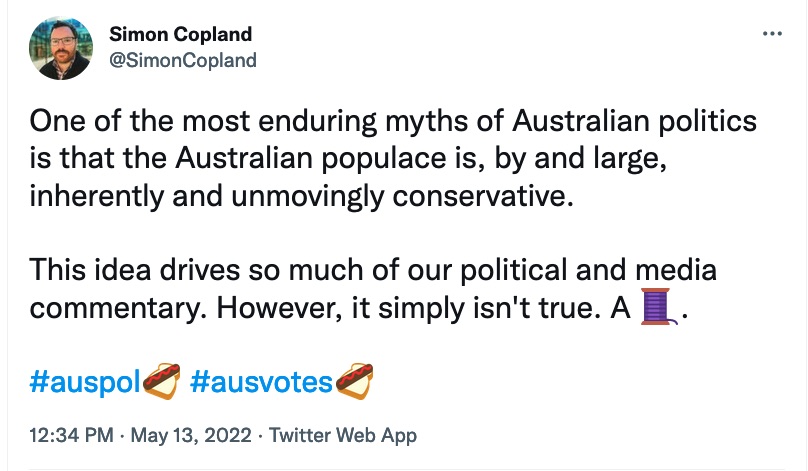 We can hope that the policy restraint or conservatism we have seen from the major parties will vanish when the new government is formed – but don’t hold your breath!
We can hope that the policy restraint or conservatism we have seen from the major parties will vanish when the new government is formed – but don’t hold your breath!
Meanwhile, there’s lots of advice out there for incoming Ministers. John Menadue’s blog, Pearls and Irritations, has run a series, including articles giving advice to the new Health Minister from Professor Stephen Duckett and Professor Emerita Mary Chiarella and John Menadue himself (If I were the Minister for Health – Pearls and Irritations (johnmenadue.com).
See also:
Do we continue down the pathway of privatisation of health by stealth by Professor Stephen Leeder Priorities for a new health minister by Charles Maskell-Knight.
The Lowitja Institute outlines key election priorities, by Adjunct Professor Janine Mohamed.
Check our election resources
Over the past week, Croakey has published a number of articles on issues around the election that are recommended reading.
Will the next parliament address this billion dollar gap in funding for Indigenous health?
This election, what’s on the agenda for LGBTIQ+ people and organisations.
Calling STOP on the harmful, punitive detention of children.
Bridging the gap in food security and inequity.
And as you prepare to head to the voting booth (if you haven’t already voted), there’s a long list of election scorecards on a variety of issues at the end of this election wrap for you to consider.
And on May 21, rejoice in the special privilege that is the right to vote and have your say in a democracy and enjoy your democracy sausages!
I’ll leave you with this quote in a new book “100% Democracy: The Case for Universal Voting“ from US political pundits EJ Dionne and Miles Rapoport.
What other country has its electoral process defined by BBQ – even if one voter expressed interest in “more vegetarian options at the sausage sizzles”?
“What is voting day without a ‘democracy sausage’?” asked Lesley Russell, a long-time Australian political activist and policy specialist, in an email interview. “The sausage sizzle is a way for the local school, hospital, fire brigade, or scout troop to raise funds, and Australians never met an occasion that was not improved with food.”
Russell added: “It is possible to vote early and by mail in Australia—but honestly, why would you when voting is a community event? Even if the United States cannot bring itself to consider compulsory voting, the least it could do is turn the first Tuesday in November into a public holiday, and declare it a day for celebrating both the privilege of voting and the local snack food of choice.”
You can watch EJ and Miles talk about their book – and how Australia has inspired them – here.
Labor’s primary care announcement – a work in progress
Labor’s announcement of a $970 million package to “strengthen Medicare” was a welcome surprise.
The package includes $750 million over three years, beginning in July 2023, to be used to improve patient access to general practice, including after-hours care, improve patient access to GP-led multidisciplinary team care, including nursing and allied health, provide greater patient affordability and better management of complex and chronic conditions to help decrease pressure on hospitals.
There is little detail as to how this will be done – that will be determined by an advisory group that along with the Australian Medical Association (AMA) and the Royal Australian College of General Practitioners (RACGP), is to include the National Aboriginal Community Controlled Health Organisation (NACCHO), consumers, nurses and allied health professionals.
A further $220 million is provided for a GP grants program will provide funding to upgrade IT systems including to support telehealth consultations, upskill staff, for the purchase new equipment, and to cover the costs of infection control measures.
It has been widely welcomed. See the positive responses from the RACGP, AMA, PHAA, and the RDAA.
However, as Dr Mukesh Haikerwal tweeted – the devil will be in the details, and I predict some old-fashioned turf fights and money grabs ahead for the Advisory Group.
I worry that this approach is more about general practice than primary care (they are not the same) or even primary healthcare, that there is nothing here to drive innovative new ways to fund and deliver primary care, and specifically to better manage patients with chronic and complex conditions in the community.
We know that the current fee-for-service system is the main barrier to this happening and that it has undermined all previous efforts to give general practice a stronger primary care focus (see for example this evaluation of a regional GP Super Clinic). As the MBS Review taskforce stated in its final report, the current system is not fit for purpose.
The doctors’ groups have already signalled that they want increased Medicare rebates. It’s a very reasonable request, but these increases must be accompanied by at least some trials of new payment methods and the guarantee of reduced out-of-pocket costs for patients.
With doctors’ groups eager to make up the current deficits in MBS reimbursement, it’s hard to see how other essential primary care professionals such as mental health nurses, nurse practitioners, physiotherapists, and nutritionists will get a look in.
The distribution of this funding must also take into account the health inequalities across the Australian electorates.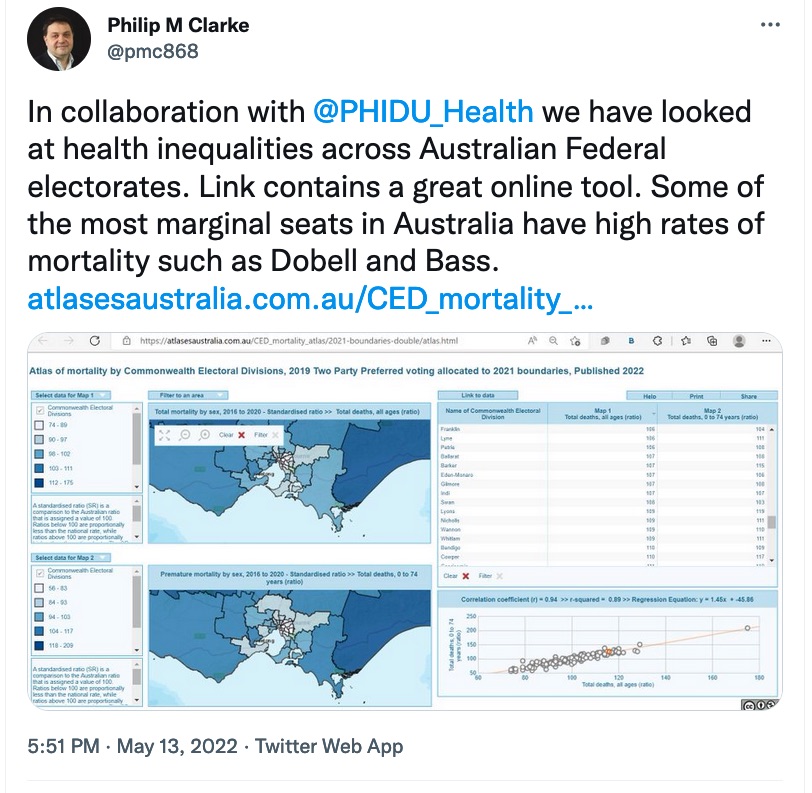
See the Atlas here.
Even given my forebodings, Labor’s commitment in this area (hopefully a down payment with more to come) is in stark contrast to that from the Morrison Government which provided only $120 million to support the 10-Year Primary Care Plan in the 2022-23 Budget (it was boosted with $108 million for an additional year of the Adult Public Dental Program, but we can all subtract!).
As he retires from politics, Greg Hunt has become more openly critical of his opponents; he didn’t hold back with his thoughts on Labor’s proposal, describing it as a “train wreck”.
“Today we’ve seen a billion-dollar slush fund from the leader of the opposition for undisclosed recipients, through undisclosed recipients, through undisclosed ministerial processes, through undisclosed parties for undisclosed purposes.”
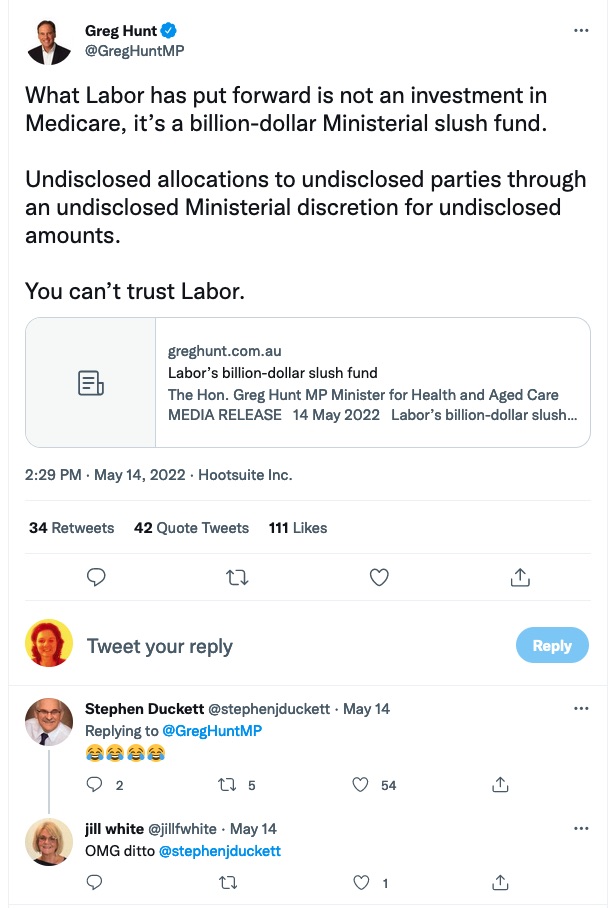
Coalition campaign launch
I’m not sure what it means to have a campaign launch just six days before the election. It might be a grab for undecided voters (but then you’re missing out on those who have already voted) or maybe campaign headquarters was trying to work out what plays best.
Anyway, the decision was clearly to let Morrison talk and talk and talk – after warm-ups from National Party Leader Barnaby Joyce and Treasurer Josh Frydenberg, who warned of the risks posed by Labor, the Greens, and the taxes they would impose.
Along with the usual numbers spiel (look what we have done for you) and constant repetition of his love for Australia, Morrison put himself forward as the saviour of the nation during the pandemic.
He reiterated previous statements that Australia faced the “abyss” of the pandemic and has prevailed, saying that he had one focus as Prime Minister – “to save the country and we did”. “We were battling the virus in real time each day” but he was also “building an economic bridge to the other side – and here we are.”
If you haven’t already seen Tracy Grimshaw’s question on A Current Affair suggesting the Prime Minister “over-egged” his statement about saving the country, then watch here.
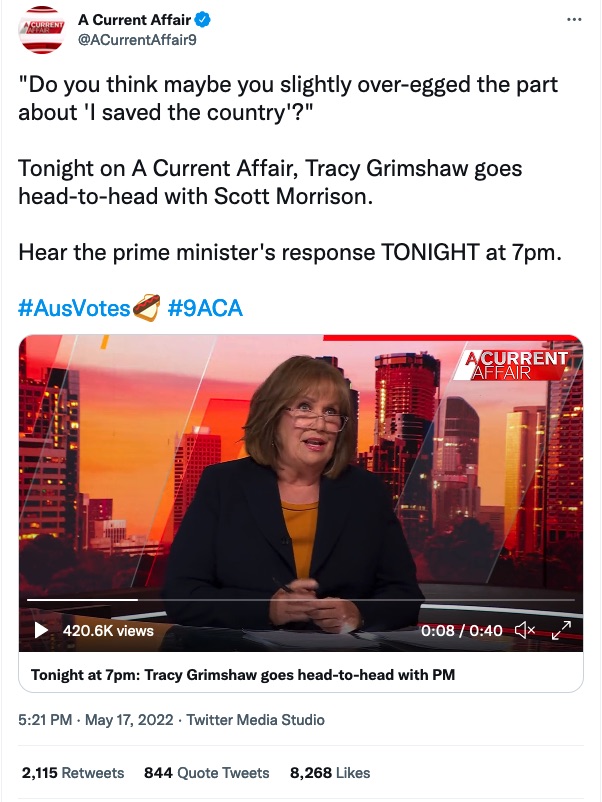 The logic was a little confused: he told us Australia was a country with a healthy, clean environment and access to affordable healthcare, where older Australian are respected and get the help they need and Indigenous Australians have the same opportunities, but then said these were the promises he would deliver if re-elected.
The logic was a little confused: he told us Australia was a country with a healthy, clean environment and access to affordable healthcare, where older Australian are respected and get the help they need and Indigenous Australians have the same opportunities, but then said these were the promises he would deliver if re-elected.
Well into his speech, Morrison paused to tell us he will now hit the extra gear needed to make things truly better. “I’ve got a big plan. I’m seeking a second term because I’m just warming up.”
He then launched into animated salesman mode over what the Coalition will do to increase home ownership (Interestingly, it turns out that the idea of using superannuation to purchase a house hasn’t always been so popular with Liberals). This was excitedly described as a gamechanger – and perhaps it is, except for those Australians unable to find affordable and decent rentals.
A 2017 tweet by Federal Environment Minister Sussan Ley.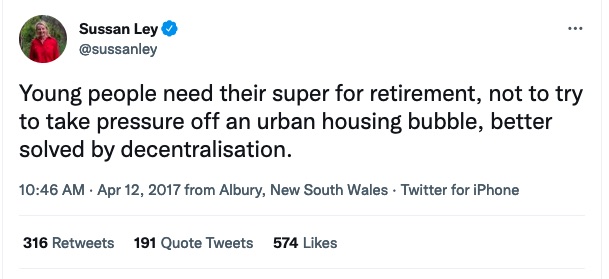
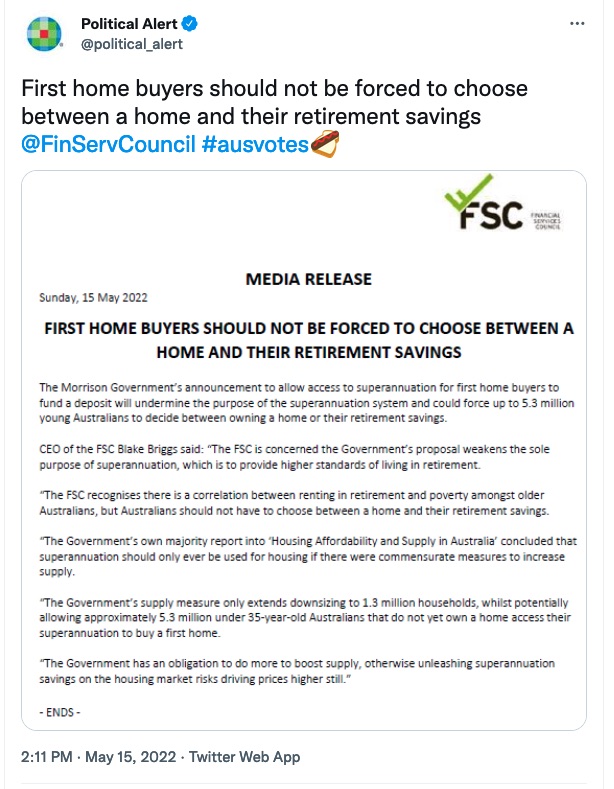 Healthcare came up only towards the end of his speech, again with a long listing of what has been done. There was a new announcement of $375 million for a new comprehensive cancer centre for Queensland, to match similar announcements previously made for Western Australia and South Australia.
Healthcare came up only towards the end of his speech, again with a long listing of what has been done. There was a new announcement of $375 million for a new comprehensive cancer centre for Queensland, to match similar announcements previously made for Western Australia and South Australia.
And finally, Morrison tells us “better days are coming”. And I thought his message was that they were already here!
On COVID, we lead the world but not in a good way
This past week, global databases showed Australia led the world in per-capita COVID-29 infections. Daily new infections have been well over 50,000 for some days, putting Australia behind only Germany and the United States.
See this 13 May Twitter thread by the Burnet Institute.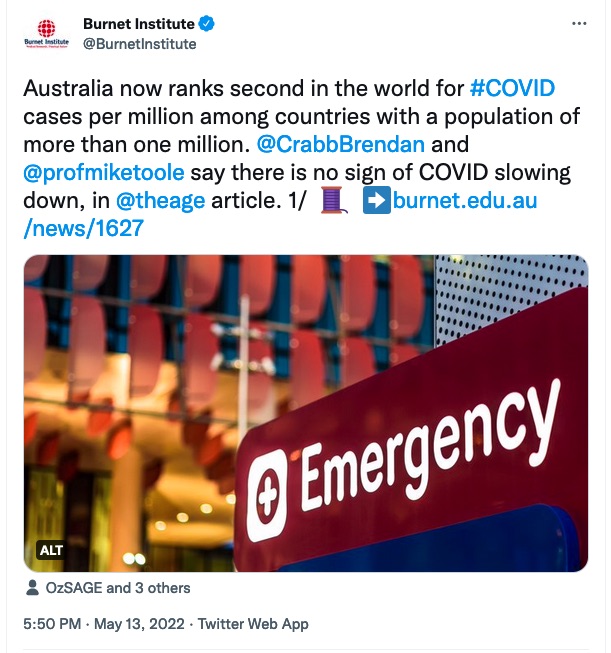 Hospitalisations and deaths are also tracking upwards, with the average number of COVID-19 related daily deaths doubling since March. To May 3 there had been 7311 COVID-19 deaths in Australia and 5072 of these were in 2022. (More data, updated daily, here)
Hospitalisations and deaths are also tracking upwards, with the average number of COVID-19 related daily deaths doubling since March. To May 3 there had been 7311 COVID-19 deaths in Australia and 5072 of these were in 2022. (More data, updated daily, here)
Australian Bureau of Statistics data show that COVID-19 is now Australia’s second leading cause of death after cancer. We can only wonder about the disease burden due to long-COVID.
Businesses, the economy and communities are feeling the impact. So many families are in mourning, yet the daily toll is never mentioned on the campaign trail. Indeed, Morrison thinks we have “come through the worst of it”.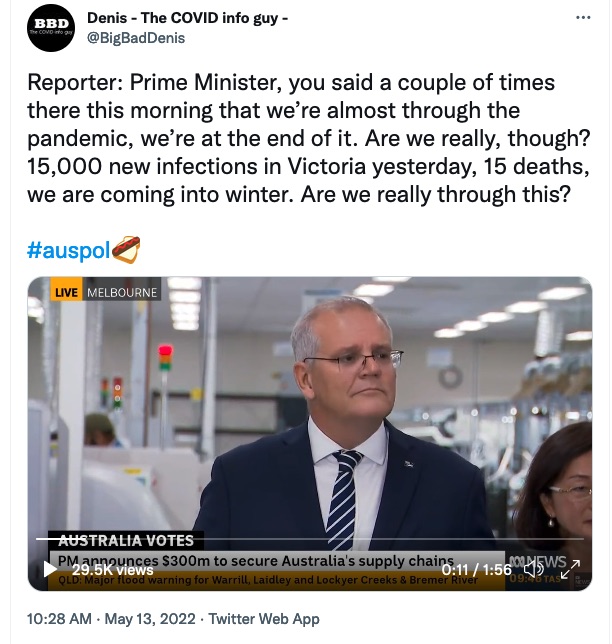
The experts say the toll will continue to rise and they are worried about new Omicron variants arriving with the winter and flu season.
I went looking for the “Winter Preparedness Plan” Morrison refers to.
I found this media release from March 11 from the Health Minister. It includes announcements and funding from the 2022-23 Budget. There is also a statement from the Australian Health Protection Principal Committee (AHPPC) on winter season preparedness.
But where are the education campaigns to push people to get their third and fourth jabs, given how protective these are?
One in four Australians has now had COVID-19 (data here) and the list of who has had COVID-19 among the politicians and bureaucrats continues to grow. Albanese says more than half of his shadow cabinet has had COVID-19 since the election campaign began.
You might think that would drive some action. But even when Morrison and Albanese got infected, there was more commentary about the impact on their campaigning than the consequences for their long-term health and vulnerable others they might have infected.
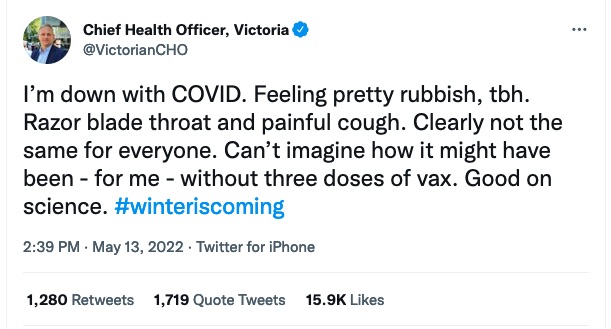
My American friends were very amused that a recent Sydney Morning Herald explainer on the current situation with the pandemic in Australia was headed “world leading or a shit show”.
The language is not very dignified – but sums things up succinctly. If you think it’s a bit too strong, then take a look at the latest figures for infections and deaths in Australian nursing homes.
And the conclusion of this explainer? We’ve done very well in terms of the immediate knee-jerk response, but there has been no vision and no ambition.
Neither wanting to get on with life nor growing weary of COVID-19 talk and restrictions are reasons for failing to act to better manage the major impacts the SARS-CoV-2 virus will continue to have on our lives into the foreseeable future.
This recent article for Croakey by Alison Barrett discusses what the next government must do to protect people’s lives and health – starting with dropping the post-COVID charade.
Also see Dr Clare Skinner on the urgent imperative for health reform to a system that is “not normal, not fair and not safe”.
Acute problems in acute care
While the Government continues to ignore the ongoing pandemic and Opposition leader Anthony Albanese has today acknowledged the need for action, its impact on the public hospital system is daily fodder for the news outlets.
Here’s a sample of recent headlines:
- ‘Hopelessly overwhelmed:’ Sydney hospitals treat patients in corridors, ambulance trolleys
- ‘A dire situation that is unprecedented’: Senior Alfred doctor quits, warning of mass burnout
- Western Australia records more than 17,000 new COVID-19 cases, sparking fears for hospitals
- Time to fix our health system that’s as broke as my leg.
- Without radical reform, the prognosis for our health system is grim
See also these Twitter threads on health system overload: The Royal Children’s Hospital, Melbourne; and Dr David Berger
There is near universal agreement that the pandemic has merely worsened an underfunded system where key health workers are burned out and leaving in droves and experienced emergency medicine specialists are constantly worried about what might go wrong in a system under such pressures.
Aside from a tepid Labor commitment to work “constructively” with the States and Territories on the need for more hospital funding, this issue has not been raised by either politicians or media personnel on the campaign trail.
Last October Morrison indicated quite strongly that (previously agreed COVID-19 funding aside) he would not give in to “shakedown politics” by spending more federal money on public hospitals. In 2021-22, $4.91 billion was provided under the National Health Reform agreements for hospital COVID-19 costs, in 2022-23 that funding declines to $934.1 million.
So often in election campaigns health policy wonks like me bemoan the focus on hospitals at the expense of prevention, early interventions and primary care.
This year is very different, as this situation – essentially a national problem, in cities and rural areas across all states – puts the lives of people who are already seriously ill or injured at risk. Moreover in many places there are extended waiting lists for non-urgent surgery to be addressed, even as admittances for COVID-19 cases are increasing.
These are not easy problems to fix and they will require new ways of thinking and addressing system integration and financing issues.
The recent report from the NSW Legislative Council Inquiry into regional, rural and remote health highlights how there must be a whole-of-government ownership of health problems, especially in non-urban areas.
And a recent rally in Albury Wodonga calling for a single-site hospital for the area gives a guide to how different governments (federal and state) might work together more efficiently to deliver cross-border services.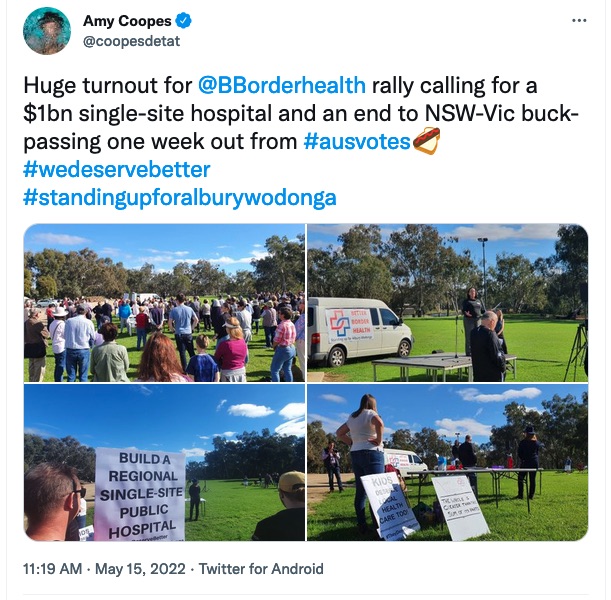
The Morrison Government has made some major election commitments for comprehensive cancer centres that will have no chance of success unless the current issues in acute care (including the healthcare workforce) are resolved.
Bulldozers and builders
It’s clear that the Coalition is fearful of its chances in this election when the Prime Minister publicly concedes that he must change his style and approach to governing.
I am bravely going to resist too much further commentary on this and the debate around whether leopards can change their spots, except for this one issue: Morrison stated that “what Australians have needed from me going through this pandemic has been strength and resilience” as a justification for his “bulldozer” (or bullying) style.
We might ask when exactly did Morrison act like a bulldozer, using this “strength and resilience” to get things done and ensure that Australians were as protected as possible from the impacts of the pandemic? His approach at the time was “it’s not a race”.
 The media interviews with Morrison as he has indulged in this introspection reveal more serious flaws on several key issues.
The media interviews with Morrison as he has indulged in this introspection reveal more serious flaws on several key issues.
“I just don’t have the same faith and belief in government [as Labor]”, he says, “I don’t believe government can solve all the problems, I never have.”
While many would agree that communities and individuals are key partners in the efforts to address the wicked problems that beset us, a key lesson that stands out from the experiences of the past two years – bushfires, floods, the pandemic, supply chain problems – is that strong and consultative political leadership and government interventions are imperative to ensuring that no-one is left behind and the national interest is protected.
And even as he emphasises the importance of limited government and people wanting government out of their lives, Morrison hypes what significant government action did during the pandemic.
A quick glance at the #AusVotesHealth2022 Election Score Card highlights how Morrison and his ministers are happily distributing tax-payer funded programs around as Coalition largesse (likely in contravention of the agreements that pertain to the government-in-caretaker-mode).
In an article for The Saturday Paper, economist Richard Denniss called this the “cargo cult campaign” and highlighted how Morrison is “dodging responsibility for big national issues while pouring billions of our public dollars into his target seats”.
So Morrison likes big government when it (and our tax dollars) work for him.
Then there is the Morrison approach to women, cuttingly summed up by Katharine Murphy in The Guardian. She sees Morrison focused on one key blokey constituency – men who might vote Labor. This, and his fraught navigation of the parliament’s #MeToo reckoning mean that he doesn’t understand why women are so angry about so many issues in today’s Australia.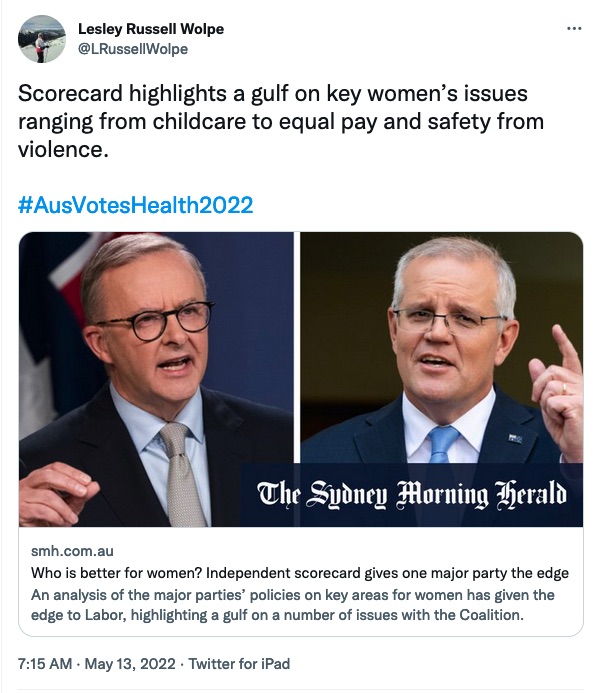
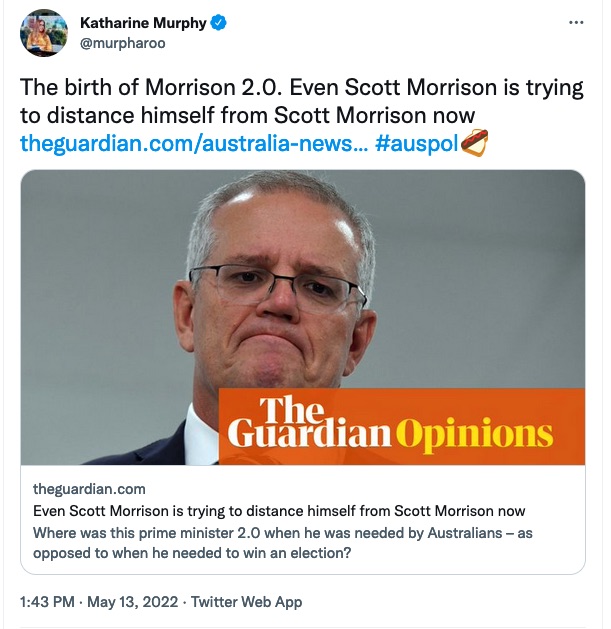
Minor parties – important but mostly ignored
If you read the polls, you will have seen that the Greens are a growing political force at this election, with their primary vote up markedly from 10 percent in 2019.
The party has a very real chance of recapturing the balance of power in the Senate.
The Greens see themselves as “the only defenders of progressive social democracy” and Leader Adam Bandt says “I think there is still a big, beating progressive heart in Australia”.
The Greens are long past a single focus on the environment and come to this election with a comprehensive suite of policies and a mechanism to pay for them.
A combination of a super profits tax on large corporations (including mining companies), levies on coal exports, and a new six percent tax on billionaires would raise some $182 billion over ten years. This would more than pay for their policies, estimated by the Parliamentary Budget Office to cost around $173 billion.
The billionaire tax (estimated to apply to around 122 people) alone would raise $40 billion. “The Greens will make Clive Palmer pay more tax so you can fix your teeth” has a certain resonance!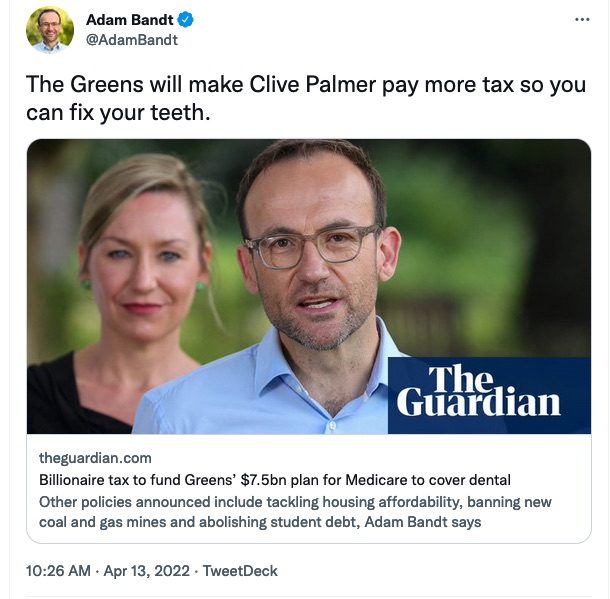 At the Greens campaign launch, held just this week, they announced a seven-point balance of power “shortlist” – although it will be interesting to see if a Labor Government would consider an alignment with them after the failures of the Rudd/Gillard years. Albanese has repeatedly ruled out doing a deal with the Greens, but has failed to answer what his party would do should they fall just short of the 76 seats they need to form government in their own right.
At the Greens campaign launch, held just this week, they announced a seven-point balance of power “shortlist” – although it will be interesting to see if a Labor Government would consider an alignment with them after the failures of the Rudd/Gillard years. Albanese has repeatedly ruled out doing a deal with the Greens, but has failed to answer what his party would do should they fall just short of the 76 seats they need to form government in their own right.
The Greens’ demands include immediate action on: no new coal and gas; dental and mental health into Medicare; building one million affordable homes and better renter rights; free childcare; wiping student debt; lifting income support; and progressing all elements of the Uluru Statement from the Heart.
The Greens attract considerably more voter support than the National Party which has parlayed its Coalition partnership and just 4.5 percent of the primary vote in 2019 into a disproportionate share of political power and funding (pork barrelling) for their electorates.
This may not last much longer. Population mobility is taking a toll on what were previously considered safe National seats and party leader Barnaby Joyce is not popular in the southern states.
The Nationals enter the election campaign with 16 lower house seats. They may lose at least one seat in Victoria (a state where Joyce has yet to campaign).
It will also be interesting to see how the Country Liberal party candidates fare in the Northern Territory (see a good explanation of the NT issues and candidates here).
At the 2019 election, turnout in Lingiari was only 72.9 percent, the lowest in the country. Most Indigenous voters live in remote communities where votes are collected by mobile polling teams, and visits by teams don’t always match with when locals are around or the communities may have sorry business.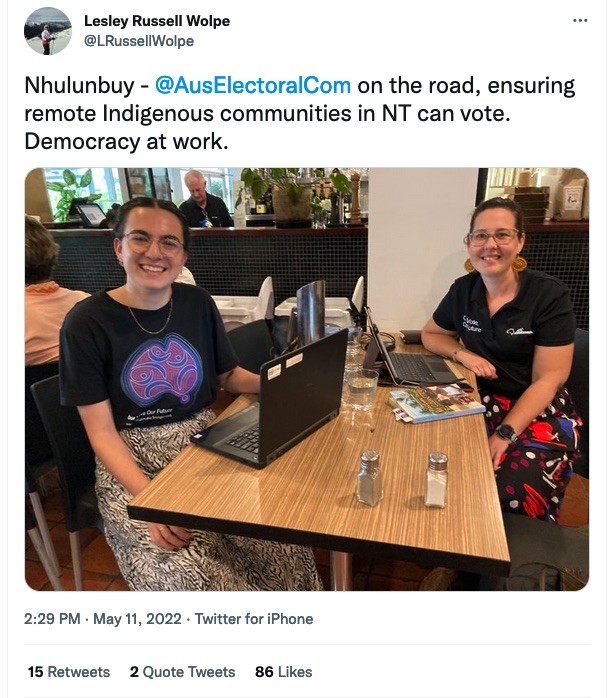
It is disappointing the LNP could not field anyone to discuss Aboriginal and Torres Strait Islander affairs on NITV this week (read more on why this matters here).
As an aside – take a look at the election policies announced on the Nationals website. Along with lots of money for agricultural research, telecommunications in the bush and sports facilities, I count over $110 million for regional university facilities and more for regional university and study centres and at least two new regional / rural centres for medical trainees.
I think that these investments are all important (especially good to see funding for a regional study hub for South East Arnhem Land which will help Indigenous students to progress their education) – provided the decisions about location are based on established need, and provided there are ongoing resources to ensure the sustainability of these new educational initiatives.
The Independents
It is very likely that Independents will take several important seats from the Liberals. In Victoria, where at least two blue ribbon Liberal seats, including that of Treasurer Josh Frydenberg, are likely to fall to “Teal Independents” the blame is being sheeted to dislike and distrust of National Party Leader Joyce on climate change.
There’s some good poll analysis here.
It’s interesting to speculate on the extent to which the Murdoch Media’s “rogue” election coverage has increased name recognition for these Independents, thus boosting their chances.
The focus on the Teal Independents obscures the enormous numbers of candidates running who are either genuine independents or are aligned with some very small political parties / movements. This article in The Guardian highlights some of them.
Fact check: Pork-barrelling
Last week retiring Health Minister Greg Hunt put out a very snarky media release about Labor’s Urgent Care clinics – which he called “Super Clinics”, presumably alluding to the Rudd/Roxon era GP Super Clinics.
These are seen by many (including the Coalition and the AMA) as failing to achieve the desired goal of reforming chronic disease management, although most of the 60 clinics promised by Labor continue to operate effectively and with community support.
It’s interesting to note that the GP Super Clinics page on the Department of Health website (which has not been updated since November 2013) claims that Super Clinics are “a key element in building a stronger national primary health care system”.
Hunt claims that individual announcements show 32 of the promised 50 sites have already been committed outside of a competitive process and that 23 or these are in marginal electorates or safe Labor seats.
ABC News reports that, based on social media coverage, it can account for claims being staked on at least 24 clinics since the policy was first announced in the first week of the campaign. ABC says that the locations appear to be evenly split between Labor and Coalition electorates — but at least 12 sites are in marginal seats, with five in government-held electorates the Opposition is hoping to win.
As someone who prides themselves on sleuthing, I must confess I can’t track anywhere near these numbers, although you can see in the “Targeted funding” section of the Election Score Card that a significant handful of such announcements have been made, presumably with the approval of Shadow Health Minister Mark Butler.
And if you look in the adjacent column, you will note that the Coalition has been very generous with targeted funding for a range of healthcare initiatives. It is a major effort to keep up to date with the electoral handouts. I find the sudden availability of funding for mental health services in electorates around the nation particularly egregious given the dire need for these over the past several years.
Moreover, in spite of the requirements for the period of caretaker government, the Liberal Party has made a number of announcements that relate to on-going government business.
Examples include announcements of new medicines listed on the Pharmaceutical Benefits Scheme, grants made from the National Suicide Prevention and Support Program, research grants made by the Medical Research Future Fund, and the agreements reached (after considerable delays) to provide mental health and suicide prevention funding allocated in the 2021-22 Budget to Western Australia and Tasmania.
Recently released documents highlight the extent to which Coalition Ministers have over-ruled advice from their departments in the awarding of government grants which went largely to Coalition seats. No wonder 31 senior judges have called for the establishment of a national integrity commission and warning of the “corrupt exercise of power”. Election 2022: Federal ICAC backed by 31 former Australian judges (smh.com.au).
Media matters
ABC Alumni, an organisation of former ABS staff, is organising a campaign to highlight the importance of the public broadcaster at a time when it has been subject to funding cuts and accusations of bias from the Morrison Government. You can read more about it here.
A key issue of contention has been the role of the Murdoch media in this election campaign. In an article first published in The Conversation and reprinted in Croakey, Denis Muller asks “As News Corp goes ‘rogue’ on election coverage, what price will Australian democracy pay?”
This is not really a media story, but it is about keeping the fact straight. Like many, I am an avid follower of the Australian Electoral Commission on Twitter – they manage to be funny and informative and just generally helpful. It’s been noticed overseas – so make sure you read this great story in the Washington Post.
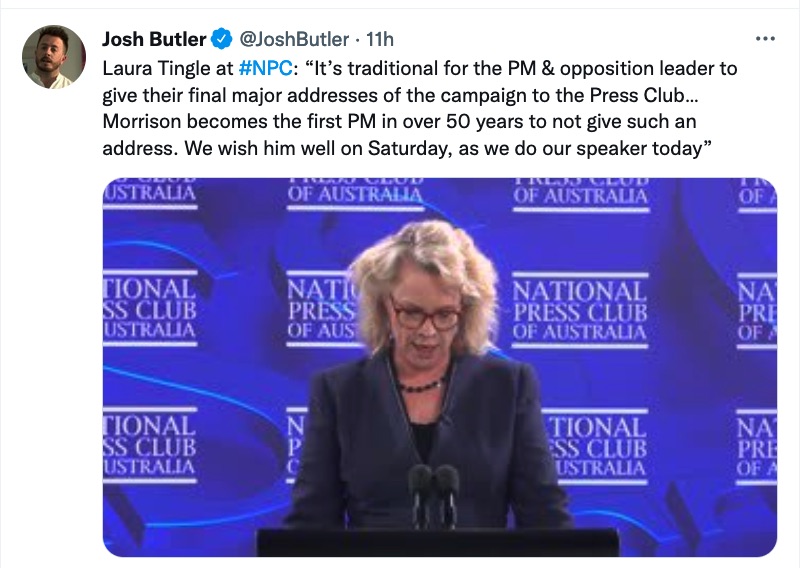
From Twitter
On policies for Aboriginal and Torres Strait Islander people
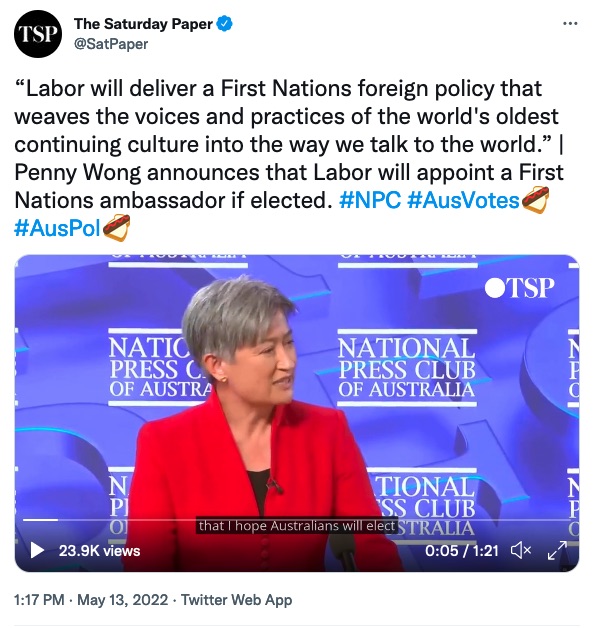
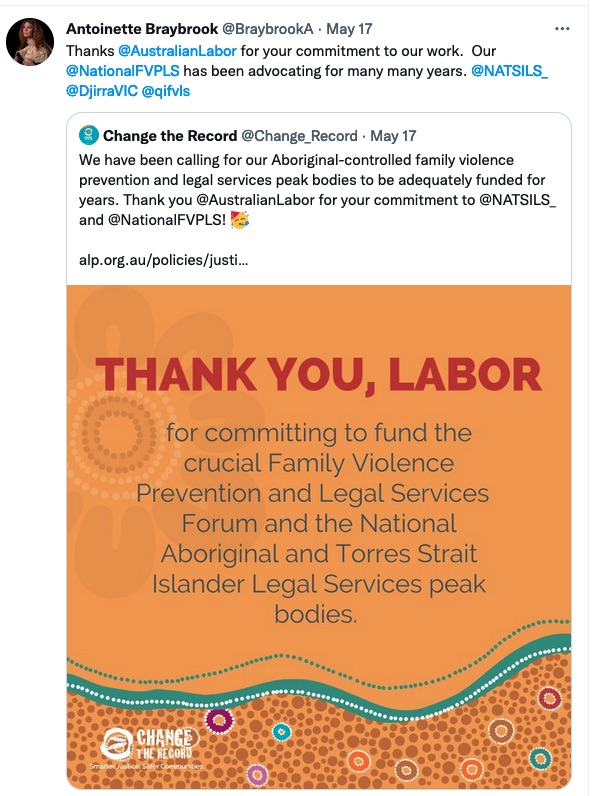
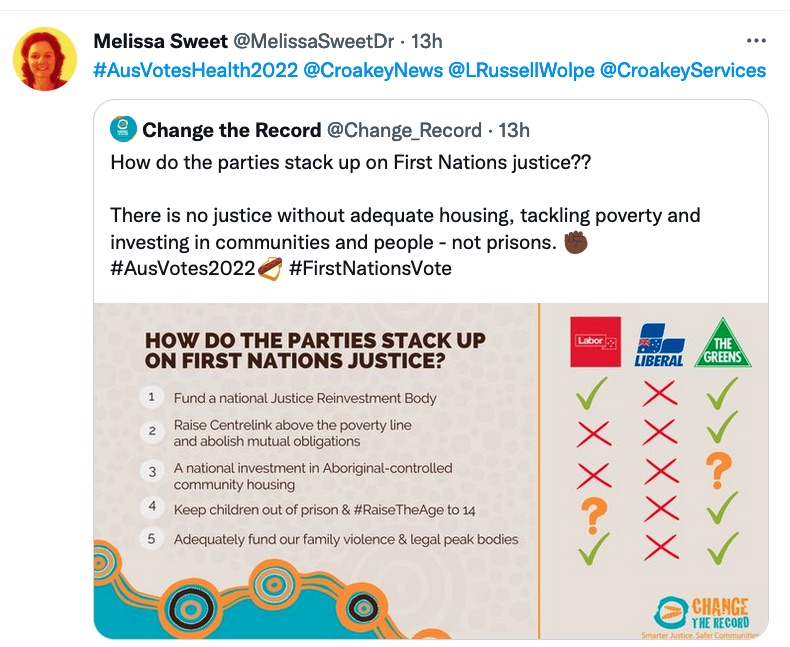
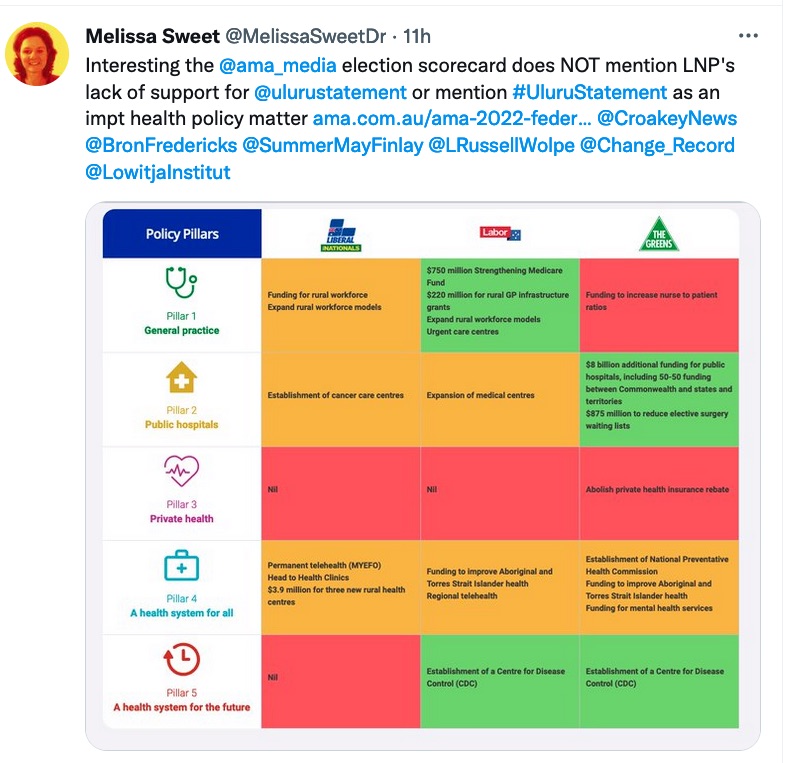
 On climate matters
On climate matters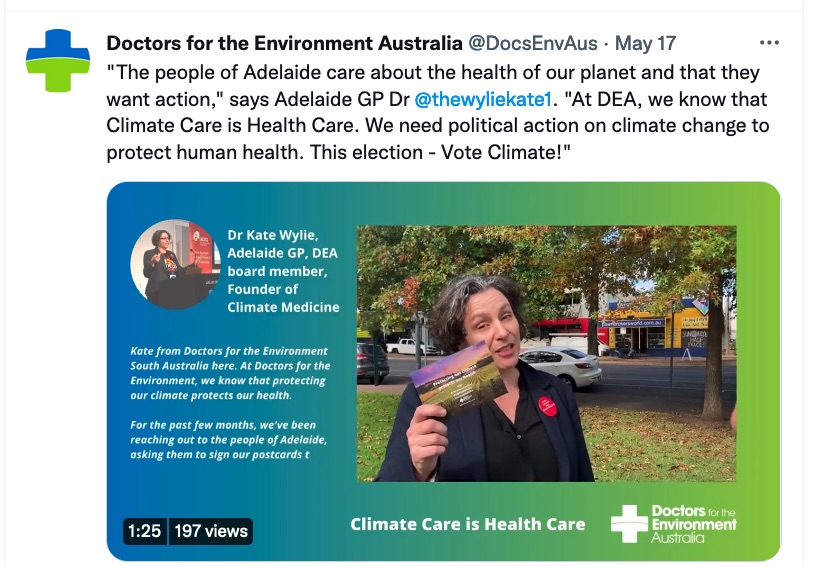
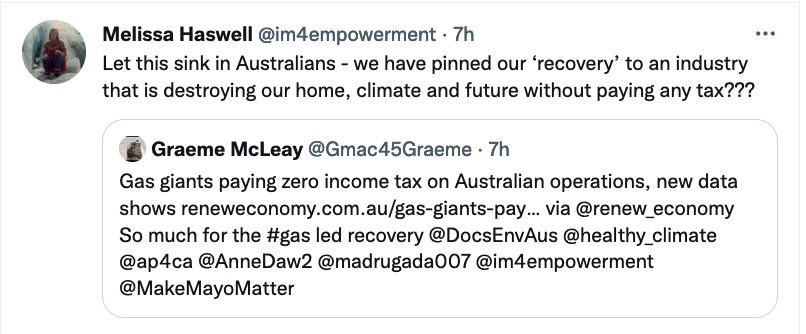
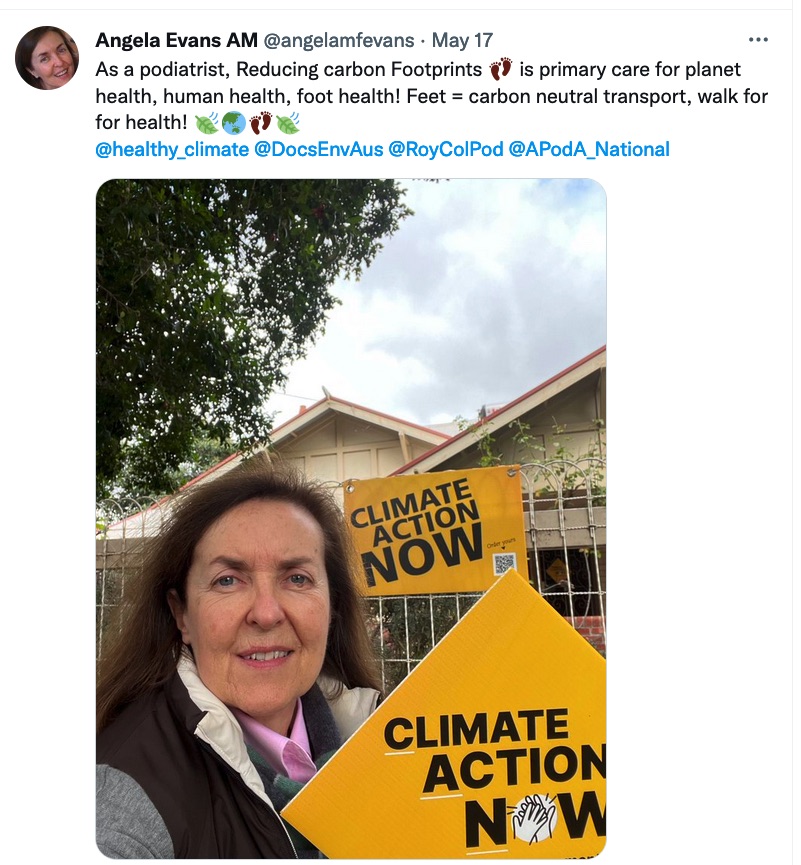
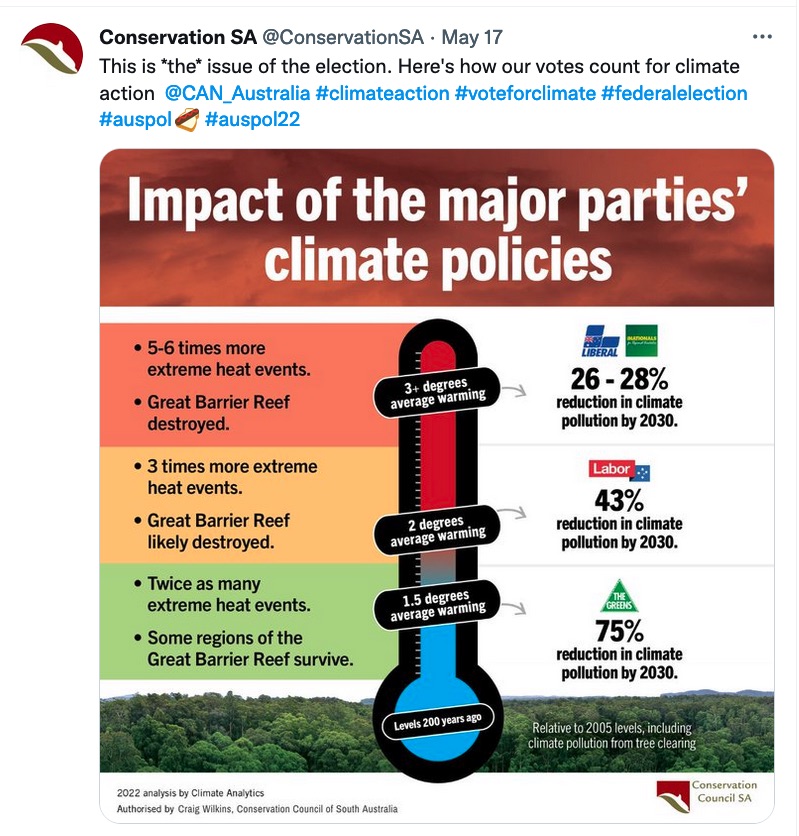
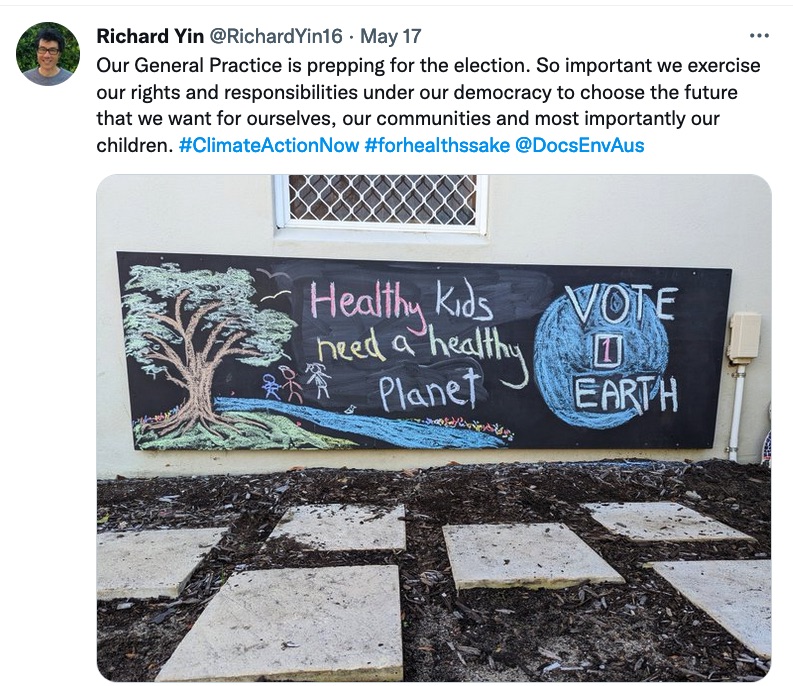 On other health matters
On other health matters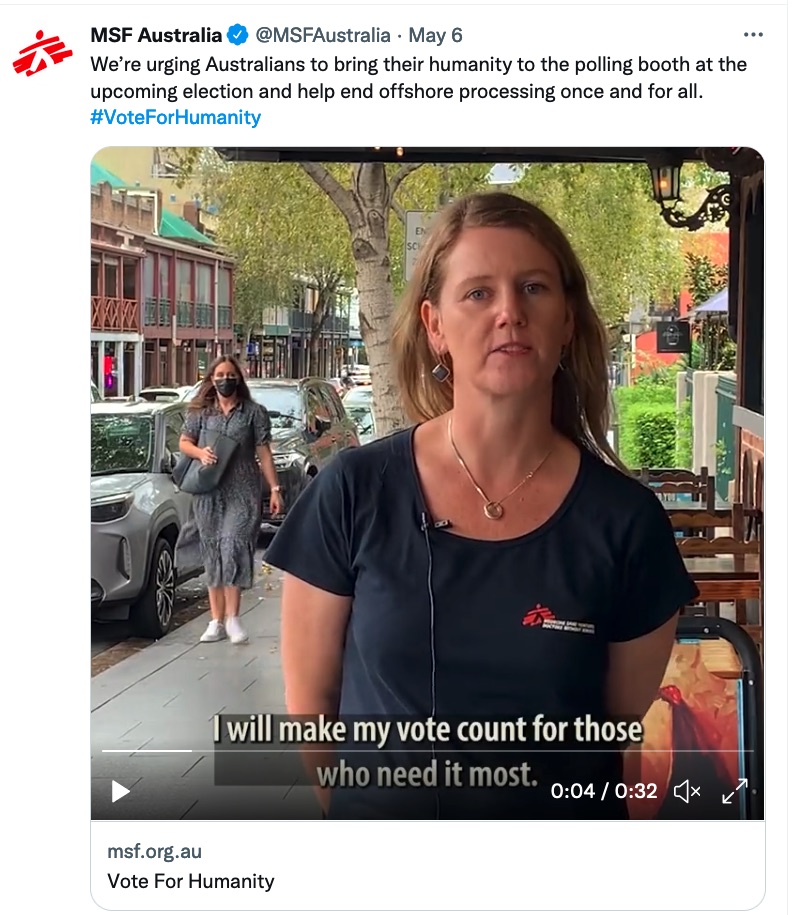
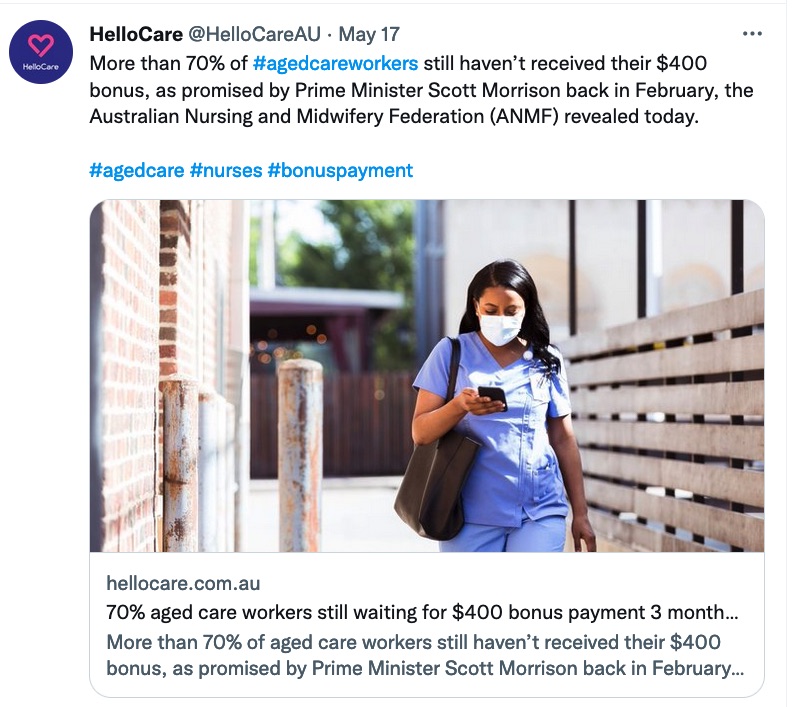
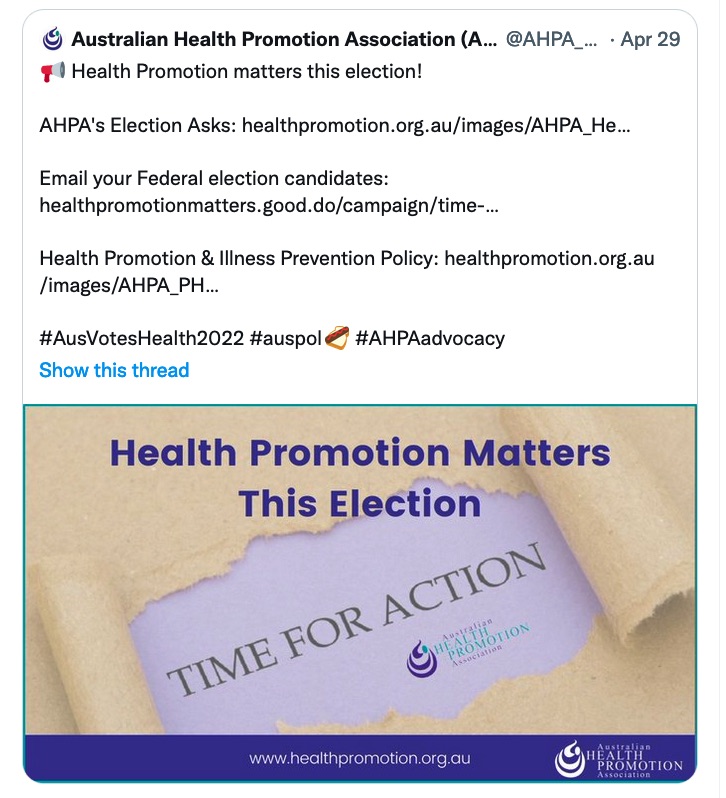
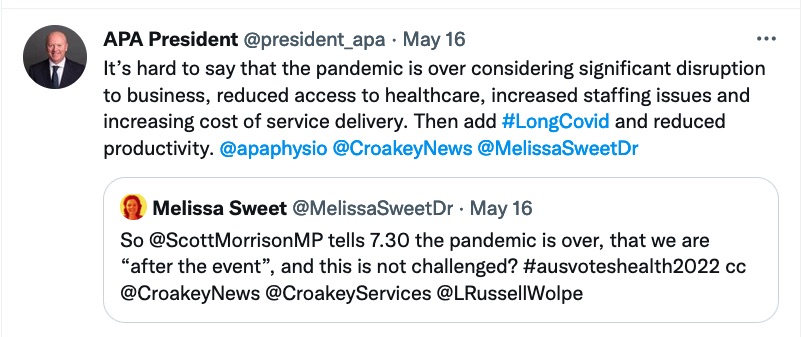

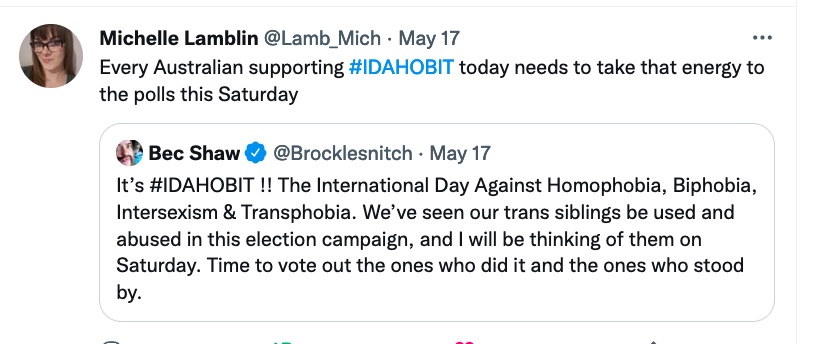
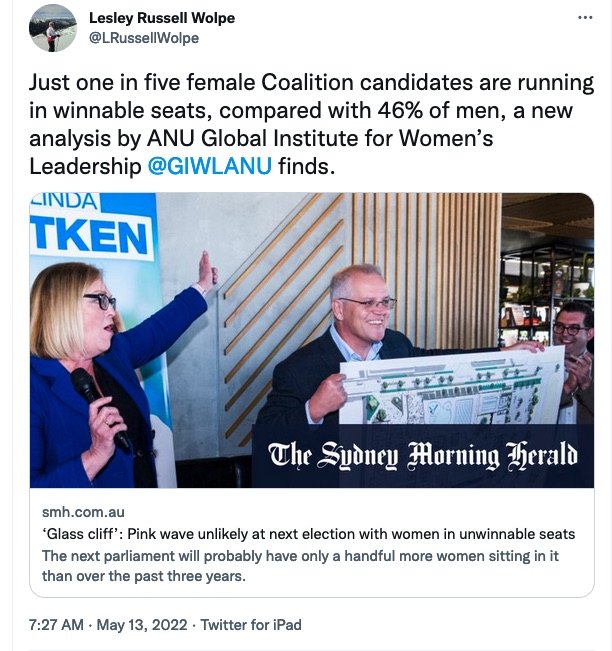
Links to election policies
ACOSS response to Greens climate policies
Allied Health Professions Australia scorecard
Asylum Seekers Research Centre election scorecard
Australian Academy of Health and Medical Sciences
Australian Aged Care Collaboration
Australasian College for Emergency Medicine
Australian College of Mental Health Nurses election priorities
Australian College of Rural and Remote Medicine
Australian Healthcare & Hospitals Association
Australian Health Promotion Association
Change the Record Election Platform and scorecard
Children’s Ground election demands
Climate and Health Alliance election scorecard
Consumers Health Forum of Australia
Council on the Ageing (COTA) Australia agenda for the next Government and Parliament
Joint statement by Australia’s suicide prevention sector, representing 40-plus organisations
LGBTIQ+ Health Australia election priorities
National Rural Health Alliance election priorities
Obesity Coalition – 2022 election priorities
Public Health Association of Australia priorities and updated scorecard
Refugee Council of Australia scorecard
Research Australia election priorities
Royal Australasian College of Physicians
The Latch: Vote for disability rights
Women with Disabilities Australia
We thank and acknowledge contributors to this compilation, including Dr Anny Huang.








